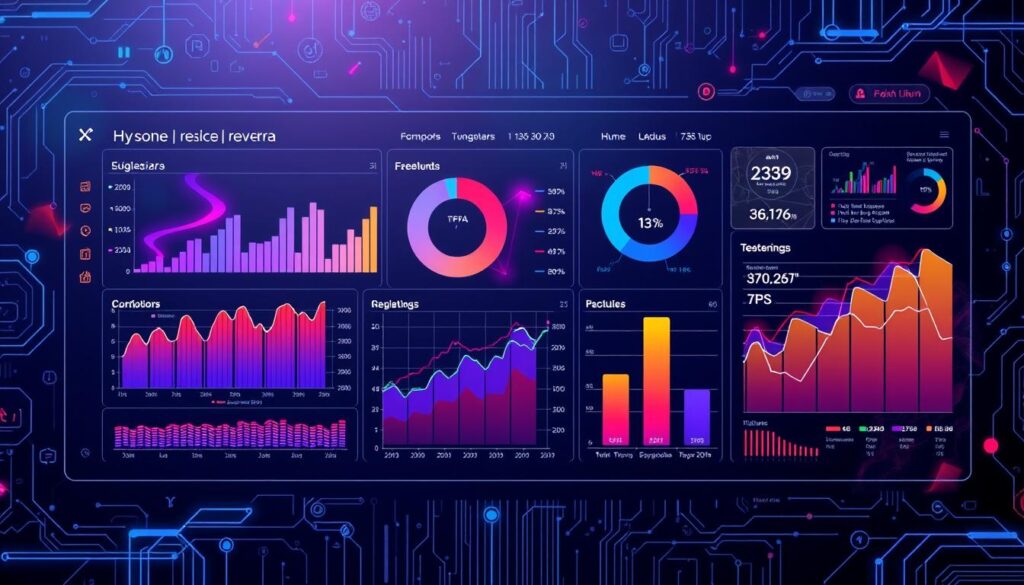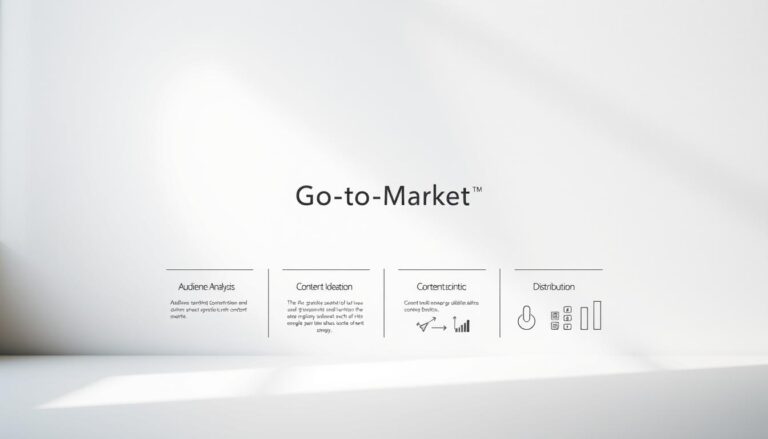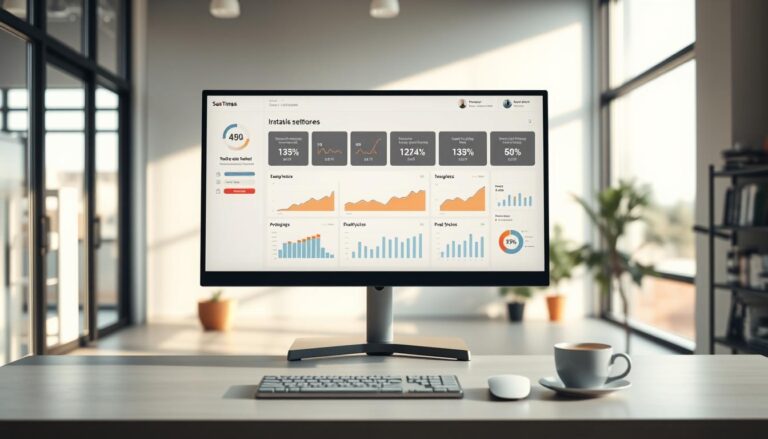In an era where data rules, the growth of advanced analytics is a game-changer for companies. The Salesforce’s State of Sales report shows a big problem. Many salespeople do not meet their goals because they are too busy with paperwork. As old ways of sales reporting become outdated, using AI for sales reports is crucial for teams wanting to hit their revenue goals.
AI systems change the game by making sales forecasts very accurate. They offer huge advantages in a competitive market. These systems make work easier and use lots of sales data to find new insights fast. Studies show that teams using AI tools see big increases in money made, proving that technology really improves sales.
Key Takeaways
- Accelerate data analysis with access to over 300 KPIs within Pipedrive for nuanced sales reporting.
- Leverage predictive analytics to forecast and improve sales performance, utilizing diverse forecasting models.
- Customize and automate sales dashboards, reducing busy work and allowing reps to focus on high-value tasks.
- Integrate advanced AI tools like Cirrus Insight Meeting AI and Zoho CRM to optimize sales processes and enhance customer engagement.
- Implement AI to drive actionable insights, automate lead generation and qualification, and support data-driven decision-making.
- Stay ahead with predictive analytics to identify potential risks and adapt strategies for a stronger sales trajectory.
- Benefit from industry leaders like Clari, Aviso, and Seismic for AI-powered sales enablement that spans the entire sales funnel.
Understanding AI-Powered Sales Reporting
Artificial intelligence (AI) is changing how businesses do sales reporting. It turns basic data crunching into deep, forward-looking insights. These insights help in making strategic decisions. With AI, companies can automate the boring parts of sales reporting. This lets them focus on strategy.
What is AI-Powered Sales Reporting?
AI-powered sales reporting uses machine learning and data analytics. It sifts through tons of data to find useful insights. This method speeds up making sales reports, thanks to automated sales report generation. Smart tools for sales analytics help businesses handle big data and predict market trends and customer needs.
Key Features of AI-Driven Systems
- Automated collection and integration of sales data from multiple channels
- Real-time analytics that offer immediate insights into sales trends
- Capacity for personalized reporting based on specific user preferences and roles
- Machine learning models that predict future sales and customer behaviors
Benefits Over Traditional Reporting
Using AI in sales reporting has major benefits over old methods:
- Efficiency: AI shortens report preparation from days to minutes. This boosts productivity.
- Accuracy: AI checks data automatically, reducing human mistakes and making reports more reliable.
- Insightful: AI looks at numbers and customer opinions. This gives a deeper understanding of what customers want and do.
- Scalable: AI systems grow with your data, making sales reporting sustainable over time.
The move to artificial intelligence in sales reporting is a key change. It is shaping how businesses operate and connect with customers. Companies adopting AI stay ahead in the fast-changing market.

Enhancing Revenue Analytics with AI
Artificial intelligence (AI) is changing how businesses use sales data. By using machine learning for sales analysis and data-driven insights for sales reporting, companies improve their revenue analytics. This leads to better decisions and enhances performance.
How AI Improves Data Accuracy
AI makes data collected by sales teams more accurate. It uses complex algorithms to find and fix errors. This means data is more reliable, helping businesses make solid strategies. With smart reporting for sales teams, AI reduces mistakes and makes revenue forecasting more trustworthy.
Real-Time Insights and Decision Making
AI offers instant insights in sales reporting. This lets sales teams quickly adjust to market changes or customer actions. According to Salesforce, AI models boost productivity and improve customer relations. This positively affects revenue and makes sales forecasting more accurate.

AI-driven solutions bring adaptive strategies using predictive analytics. This gives businesses a competitive advantage. They can anticipate market trends and adjust their strategies as needed.
| Year | Revenue Before AI | Revenue After AI | Growth |
|---|---|---|---|
| 2019-2021 | Declining | Stabilized | N/A |
| 2022 | 20% below target | On target | 20% Improvement |
| 2023-2025 (Projected) | Stable | Growth (12.1% CAGR) | 12.1% Annually |
AI’s role in improving data accuracy and delivering immediate insights is crucial for modern sales strategies. By using AI tools, companies get more precise sales forecasts. They also provide their teams with smart reporting capabilities. This is essential for success in today’s competitive market.
Implementing AI Sales Reporting Solutions
Implementing AI in sales reporting boosts productivity and analysis. It’s crucial to pick the right AI tools, integrate them well, and train your team. This approach elevates business operations significantly.
Choosing the Right AI Tools
Choosing the right AI tools is key to better sales reporting. Tools like predictive analytics and AI prospecting tools, such as ChatGPT and Regie, use past data and smart algorithms. They forecast sales trends and improve lead generation accurately.
Integration with Existing Systems
Integrating AI with current sales platforms is vital. For example, Salesforce integrates easily with AI, enhancing predictive analytics. This smooth integration allows for deep sales data analysis, leading to smarter decisions and plans.
Training Your Team for Success
Training is crucial for using AI in sales reporting. Providing courses and resources, like IBM Training, boosts AI tool understanding and skill among team members. It ensures the AI-driven sales tasks are used effectively.
Statistical Data on AI Sales Reporting Solutions
- 90% of commercial leaders plan to use AI frequently within two years (McKinsey & Company).
- Adoption of AI is linked with a revenue increase of 13-15% and sales ROI improvement of 10-20% (McKinsey & Company).
- Approximately 30% of sales tasks can be automated using AI, enhancing efficiency and freeing up time for strategic activities.
- Sales teams using AI have seen a 50% increase in both leads and appointments, showcasing the potent impact of AI on sales performance.
| Feature | Benefit |
|---|---|
| Predictive Sales Analytics | Forecasts sales trends, improving preparedness and strategic planning. |
| AI-Driven Prospecting | Efficiently scores and prioritizes leads, focusing efforts on potential conversions. |
| Integration with Salesforce | Seamless data sync and reporting, enhancing user experience and data reliability. |
| Training Programs | Upskills team, ensuring effective use of AI tools and techniques. |
Case Studies: Success Stories of AI in Sales
AI has changed how businesses operate and interact with customers. Looking at specific examples, we see AI’s big impact in sales. This is true for both retail and B2B settings.
Retail Sector Success Examples
In retail, AI has been a game-changer. Big retail chains use AI to understand customer data better. This leads to improved recommendations and personalized shopping. As a result, customer loyalty and sales go up. For example, ACI Corporation saw its sales conversion rate jump from under 5% to 6.5%. They also got more qualified leads.
AI also helps keep the right products in stock. This makes sure popular items are always available. It also avoids wasting space on items that don’t sell well. This is crucial for making more money.
B2B Companies Leveraging AI Insights
B2B companies use AI to better understand what their clients need. AI helps identify potential buyers and key decision-makers more accurately. For instance, Capgemini saw a 40% rise in high-intent leads. This greatly improved their marketing results.
AI improves how companies communicate with potential clients. It makes following up more dynamic. This matches better with what clients are looking for.
| Company | Improvement in Sales Conversions | Improvement in Qualified Leads |
|---|---|---|
| ACI Corporation | From <5% to 6.5% | From 45.5% to 64.1% |
| Capgemini | 40% increase in high-intent leads | 4.8x increase in marketing-qualified leads |
These cases show how AI in sales leads to big wins. It removes inefficiencies and helps businesses grow. AI improves how we forecast, understand customers, and place products. This leads to happier customers and more sales.
Future Trends in AI-Powered Sales Reporting
The future of automated sales analysis is both exciting and full of challenges. AI changes in sales analytics promise to reshape sales strategies. Bloomberg Intelligence predicts the AI industry will grow by 42% CAGR. This adds $280 billion in new software revenue. It’s no surprise that 47% of top tech leaders focus their budgets on AI.
Advancements on the Horizon
In the near future, 35% of Chief Revenue Officers plan to create centralized “GenAI Operations” teams. This could happen by 2025. We’re close to a major change in how sales data is handled. AI could add up to $15.7 trillion to the global economy by 2030. In the US, GenAI users are expected to jump from 7.8 million in 2022 to 100 million by 2024’s end. This isn’t just growth; it’s a revolution in sales enablement.
Potential Challenges and Solutions
Embracing AI’s progress comes with challenges. Overcoming AI sales reporting challenges involves many layers. According to Hubspot, 44% of companies face problems from AI inaccuracies. Some worry about becoming obsolete in the AI age. However, top firms expect over 20% productivity gains with GenAI. It’s a time of transition and merging, with AI set to become as common as the internet in the workplace. It will be key for growth, engaging customers, and making precise decisions.
FAQ
What is AI-Powered Sales Reporting?
AI-powered sales reporting uses artificial intelligence to improve sales reports. It generates sales reports automatically. This provides better sales forecasting and helps in making sales more efficient.
What are the Key Features of AI-Driven Systems?
AI-driven systems offer automated data checks and predict customer habits. They help in engaging customers personally. These systems can analyze sales data, understand customer feelings, and give insights right away. This helps in making smart decisions.
How do AI-Driven Systems Benefit Over Traditional Reporting?
AI-driven systems save time and improve data quality. They help in making informed decisions ahead of time. AI makes sales methods more precise. This leads to better sales strategies and more income.
How Does AI Improve Data Accuracy in Sales Reporting?
AI enhances data accuracy by fixing errors with machine learning. It updates data in real-time. This makes business data trustworthy. AI gets better over time, improving forecasts.
How Are Real-Time Insights and Decision Making Enhanced by AI?
AI quickly processes lots of data and spots sales trends. It stays updated with new info. This leads to smart reports and quick, wise decisions.
What Should be Considered When Choosing the Right AI Tools for Sales Reporting?
Choose AI tools that work well with your sales systems. Look for advanced analytics and sales forecasting. The right tool fits your company’s needs and grows with you.
Why is Integration with Existing Systems Important for AI Sales Reporting?
Integration makes the sales process smooth and prevents data issues. It lets AI tools analyze all sales data for better forecasts. This leads to smarter business moves.
What Role Does Training Play in Ensuring Team Success with AI Analytics?
Training is key for teams to use AI analytics well. It helps teams understand and use AI insights. This boosts sales strategies and performance.
Can You Provide Examples of Retail Sector Success with AI-Driven Sales?
AI has helped retail companies know what customers want and sell more. It gives tips on managing stocks and marketing. AI makes customer service and sales better.
How Are B2B Companies Leveraging AI Insights for Sales Success?
B2B companies use AI to understand clients and sell better. AI finds leads and speeds up sales. It helps give personalized service to clients.
What Advancements in AI-Powered Sales Reporting Are Expected in the Future?
AI will get better at forecasting and analyzing data in real-time. Sales tools will become more automated and integrated. This means more accurate decisions and customer interactions for sales teams.
What are the Potential Challenges and Solutions Associated with AI in Sales Reporting?
AI challenges include trust in data, fast changes, and limited resources. Solutions include combining tech wisely, training sales teams well, and focusing on data accuracy. This makes the most of AI in sales.



